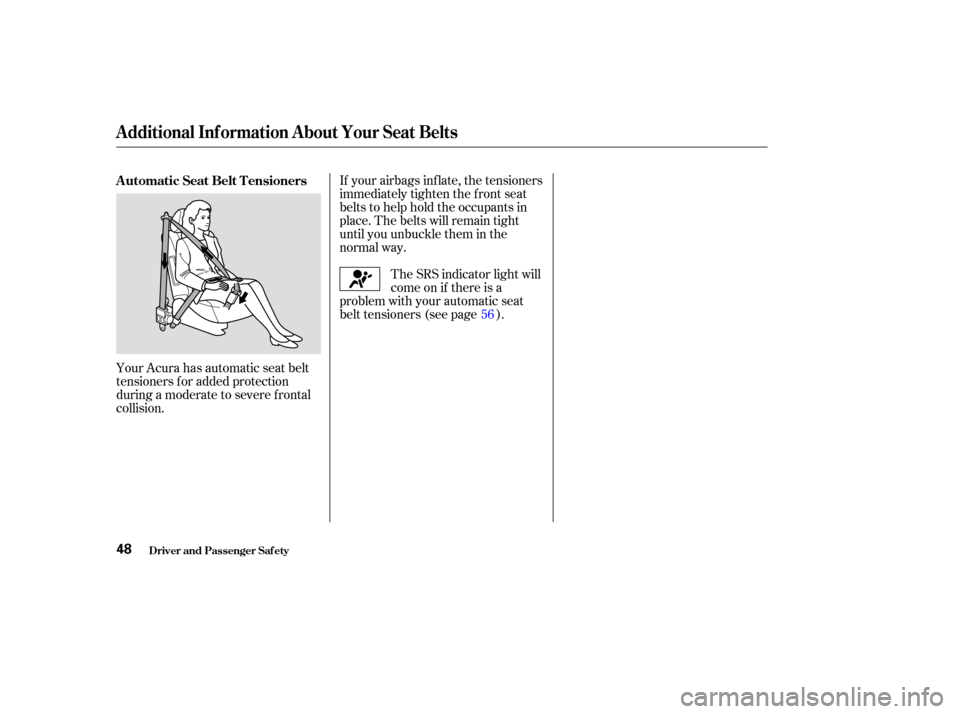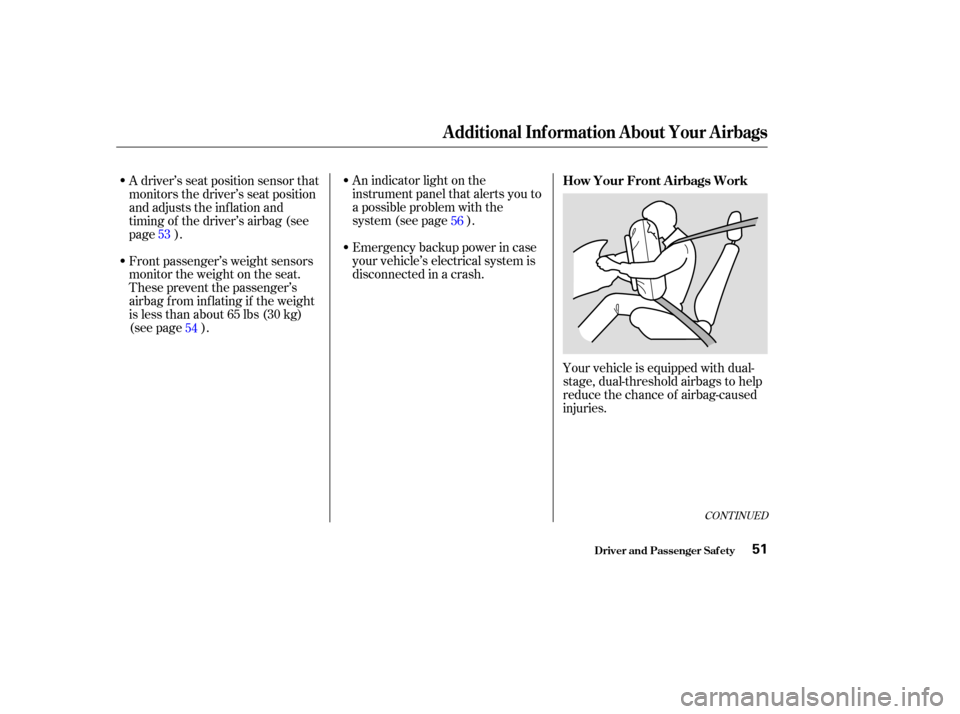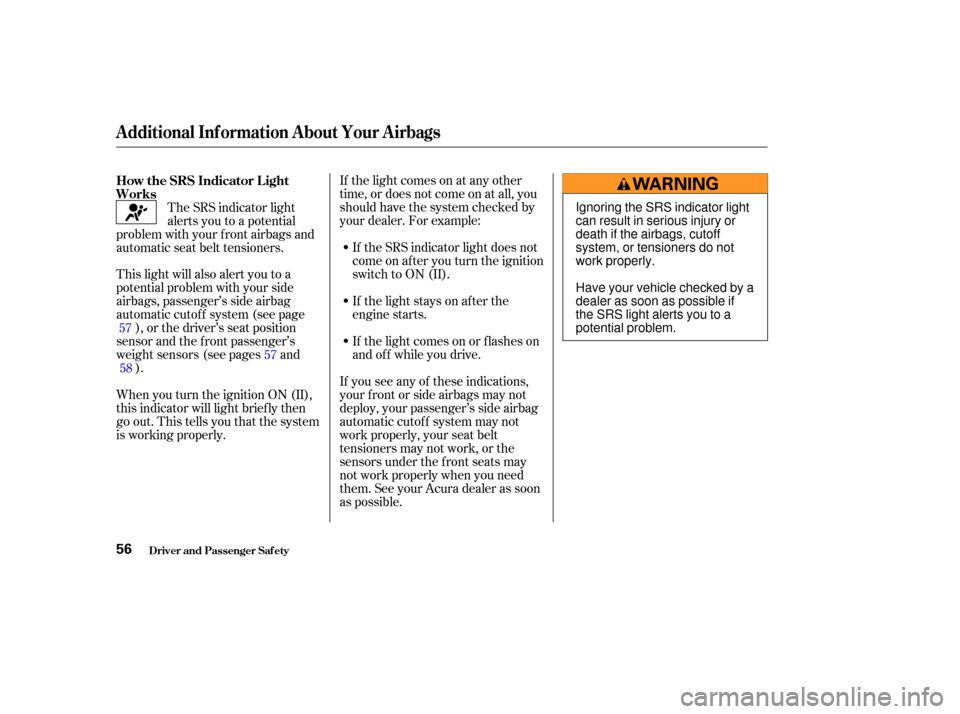Acura MDX 2003 Owner's Manua
Manufacturer: ACURA, Model Year: 2003, Model line: MDX, Model: Acura MDX 2003Pages: 420, PDF Size: 5.46 MB
Page 51 of 420

The seat belts in all seating positions
except the driver’s have an additional
locking mechanism that must be
activated to secure a child seat. (See
pages and f or instructions on
how to secure child seats with this
type of seat belt.)
If the shoulder part of the belt is
pulled all the way out, the locking
mechanism will activate. The belt
will retract, but it will not allow the
passenger to move f reely.
To deactivate the locking
mechanism, unlatch the buckle and
let the seat belt f ully retract. To
ref asten the belt, pull it out only as
f ar as needed.
See page f or instructions on how
to wear the lap/shoulder belt
properly.
To fasten the belt, insert the latch
plate into the buckle, then tug on the
belt to make sure the buckle is
latched.
To unlock the belt, push the red
PRESSbuttononthebuckle.
Guide the belt across your body so
that it retracts completely. After
exiting the vehicle, be sure the belt
is out of the way and will not get
closed in the door.
All seat belts have an emergency
locking retractor. In normal driving,
the retractor lets you move f reely in
your seat while it keeps some
tension on the belt. During a collision
or sudden stop, the retractor
automatically locks the belt to help
restrain your body.
153632
Additional Inf ormation About Your Seat Belts
Driver and Passenger Saf ety47
Page 52 of 420

If your airbags inf late, the tensioners
immediately tighten the f ront seat
belts to help hold the occupants in
place. The belts will remain tight
until you unbuckle them in the
normal way.The SRS indicator light will
come on if there is a
problem with your automatic seat
belt tensioners (see page ).
Your Acura has automatic seat belt
tensioners f or added protection
during a moderate to severe frontal
collision. 56
A utomatic Seat Belt T ensioners
Driver and Passenger Saf ety
Additional Inf ormation About Your Seat Belts
48
Page 53 of 420

For saf ety, you should check the
condition of your seat belts regularly.
Pull each belt out f ully and look f or
f rays, cuts, burns, and wear. Check
that the latches work smoothly and
that the lap/shoulder belts retract
easily. Any belt not in good condition
or not working properly will not
provide good protection and should
be replaced as soon as possible.For inf ormation on how to clean your
seat belts, see page . Automatic seat belt tensioners that
deployed during a crash must be
replaced. If a seat belt is worn during a crash,
it must be replaced by the dealer. A
belt that has been worn during a
crash may not provide the same level
of protection in a subsequent crash.
The dealer should also inspect the
anchors f or damage and replace
them if needed.
Acura provides a lif etime warranty
on seat belts. Acura will repair or
replace any seat belt component that
f ails to f unction properly during
normal use. Please see your
booklet f or
details.
355
Acura
Warranty Inf ormation
Seat Belt Maintenance
Additional Inf ormation About Your Seat Belts
Driver and Passenger Saf ety
U.S. Models
49
Not checking or maintaining
seat belts can result in serious
injury or death if the seat belts
do not work properly when
needed.
Check your seat belts regularly
and have any problem
corrected as soon as possible.
Page 54 of 420

Your Supplemental Restraint System
(SRS) includes:Automatic seat belt tensioners
(see page ). Two f ront airbags. The driver’s
airbag is stored in the center of
the steering wheel; the f ront
passenger’sairbagisstoredinthe
dashboard. Both are marked ‘‘SRS
AIRBAG.’’
Sensors that can detect a
moderate to severe frontal
collision.
A sophisticated electronic system
that continually monitors and
records inf ormation about the
sensors, the control unit, the
airbag activators, and driver and
passenger seat belt use when the
ignition is ON (II). 48
SRS Components
Additional Inf ormation About Your Airbags
Driver and Passenger Saf ety50
(5)
(8)
(3)
(7)
(4)
(4) (6)
(5)(7)(2)
(9)
(9) (10)
(8)(1)
(1) Driver’s Airbag
(2) Front Passenger’s Airbag
(3) Control Unit
(4) Seat Belt Tensioners
(5) Side Airbags
(6) Driver’s Seat Position Sensor
(7) Front Passenger’s Weight Sensors
(8) Front Sensor
(9) Side Impact Sensors
(10) Passenger Airbag Cutoff Indicator
Page 55 of 420

CONT INUED
An indicator light on the
instrument panel that alerts you to
a possible problem with the
system (see page ).
Emergency backup power in case
your vehicle’s electrical system is
disconnected in a crash.Your vehicle is equipped with dual-
stage, dual-threshold airbags to help
reduce the chance of airbag-caused
injuries.
A driver’s seat position sensor that
monitors the driver’s seat position
and adjusts the inf lation and
timing of the driver’s airbag (see
page ).
Front passenger’s weight sensors
monitor the weight on the seat.
These prevent the passenger’s
airbag from inflating if the weight
is less than about 65 lbs (30 kg)
(see page ).
53
54 56
How Your Front Airbags Work
Additional Inf ormation About Your Airbags
Driver and Passenger Saf ety51
Page 56 of 420

Af ter inf lating, the f ront airbags
immediately def late, so they won’t
interf ere with the driver’s visibility,
or the ability to steer or operate
other controls.
The total time for inflation and
def lation is approximately one-tenth
of a second, so f ast that most
occupants are not aware that the
airbags deployed until they see them
lying in their laps.
Since both airbags use the same
sensors, both airbags normally
inf late at the same time. However, it
is possible f or only one airbag to
inf late.
This can occur when the severity of
a collision is at the margin, or
threshold, that determines whether
or not the airbags will deploy. In
such cases, the seat belt will provide
suf f icient protection, and the
supplemental protection of f ered by
the airbag would be minimal.
During a f rontal crash, your seat
belts help restrain your lower body
and torso. Your airbag provides a
cushion to help restrain and protect
your head and chest. If you ever have a moderate to
severe f rontal collision, the sensors
will detect the vehicle’s rapid
deceleration. If the rate of
deceleration is high enough, the
control unit will instantly inf late the
f ront airbags.
Additional Inf ormation About Your Airbags
Driver and Passenger Saf ety52
Page 57 of 420

After a crash, you may see what
looks like smoke. This is actually
powder f rom the airbag’s surf ace.
Although the powder is not harmf ul,
people with respiratory problems
mayexperiencesometemporary
discomf ort. If this occurs, get out of
the vehicle as soon as it is saf e to do
so.Your vehicle has a driver’s seat
position sensor as a part of the
advanced airbag system. The sensor
is located on the inside of the lef t
seat rail under the driver’s seat. This
sensor monitors the driver’s seat
sliding position and sends the
inf ormation to control unit. The
control unit will control adequate
inf lation and timing of the driver’s
airbag.
Do not put any cargo or metal
objects under the driver’s seat, and
do not cover the sensor with
anything, including the rear seat
passenger’s f eet.
This will cause the sensor to work
improperly and will damage it.If there is a problem in the sensor,
the SRS indicator in the instrument
panel comes on. In this case, the
driver’s airbag will inf late normally
during a crash regardless of the
driver’s seating position.
CONT INUED
Driver and Passenger Saf ety
Additional Inf ormation About Your Airbags
Driver’s Seat Posit ion Sensor
53
Page 58 of 420

Your vehicle has front passenger’s
weightsensorsaspartof the
advanced airbag system. They are
located under both of the f ront
passenger’s seat rails. These sensors
monitor the weight on the seat at the
seat cushion, seat-back, seat-back
pocket, and seat rails.
If the total weight on the seat is
about65lbs(30kg)orless,the
system shuts of f the f ront passenger’s
airbag and the passenger airbag
cutof f indicator comes on. It reminds
you that the f ront passenger’s airbag
will not inf late during a crash.
If there is no passenger in the f ront
passenger’s seat, the passenger
airbag cutoff indicator does not
come on, however the system shuts
of f the f ront passenger’s airbag.The driver’s and f ront passenger’s
seat sensors may not work properly
if :
For additional information on how
your airbags work, see the booklet
titled
that came with your
owner’s manual.
For additional information on how
your airbags work, ask your dealer
f or a copy of the booklet titled
You do not wear your seat belt
properly.
You do not sit upright and as f ar
back as possible f rom the steering
wheel or the dashboard (see page
).
You do not secure the child seat
properly, and move the f ront seat
as far back as possible.
Be caref ul not to spill any liquids.
Spilled liquids could damage the
sensors under the f ront seats.
If your vehicle sustains a severe
impact, have the driver’s seat
position sensor and the f ront
passenger’s weight sensors
inspected by your Honda dealer. 18
SRS: What You Need to Know
About Airbags
SRS:
What You Need to Know About Airbags
.
Additional Inf ormation About Your Airbags
Driver and Passenger Saf ety
Front Passenger’s Weight Sensors
Canadian Owners
U.S. Owners
54
Page 59 of 420

Your vehicle is equipped with side
airbags f or the driver and a f ront
seat passenger. The airbags are
stored in the outer edges of the f ront
seat-backs, and both are marked
‘‘SIDE AIRBAG.’’If you ever have a moderate to
severe side impact, the sensors will
detect rapid deceleration and signal
the control unit to instantly inf late
either the driver’s or the passenger’s
side airbag.
Only one airbag will deploy during a
side impact. If the impact is on the
passenger’s side, the passenger’s
side airbag will deploy even if there
is no passenger.
To get the best protection f rom the
side airbags, front seat occupants
should wear their seat belts and sit
upright and well back in their seats.
How Your Side A irbags Work
Additional Inf ormation About Your Airbags
Driver and Passenger Saf ety55
Page 60 of 420

If the light comes on at any other
time, or does not come on at all, you
should have the system checked by
your dealer. For example:If the SRS indicator light does not
come on after you turn the ignition
switch to ON (II).
If the light stays on after the
engine starts.
If the light comes on or f lashes on
andoff whileyoudrive.
The SRS indicator light
alerts you to a potential
problem with your f ront airbags and
automatic seat belt tensioners.
This light will also alert you to a
potential problem with your side
airbags, passenger’s side airbag
automatic cutoff system (see page ), or the driver’s seat position
sensor and the f ront passenger’s
weight sensors (see pages and ).
When you turn the ignition ON (II),
this indicator will light brief ly then
go out. This tells you that the system
is working properly. If you see any of these indications,
your f ront or side airbags may not
deploy, your passenger’s side airbag
automatic cutoff system may not
work properly, your seat belt
tensioners may not work, or the
sensors under the f ront seats may
not work properly when you need
them. See your Acura dealer as soon
as possible.
57
57
58
How the SRS Indicator L ight
Works
Additional Inf ormation About Your Airbags
Driver and Passenger Saf ety56
Ignoring the SRS indicator light
can result in serious injury or
death if the airbags, cutoff
system, or tensioners do not
work properly.
Have your vehicle checked by a
dealer as soon as possible if
the SRS light alerts you to a
potential problem.